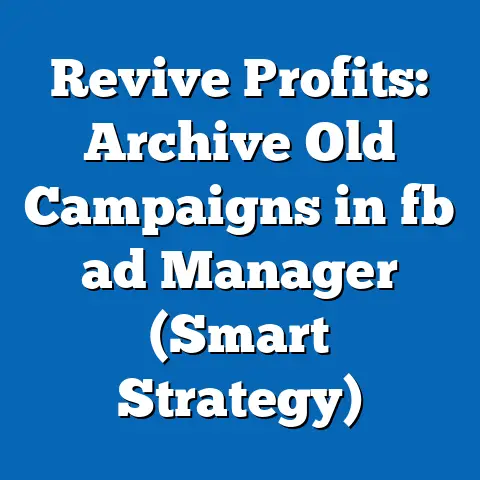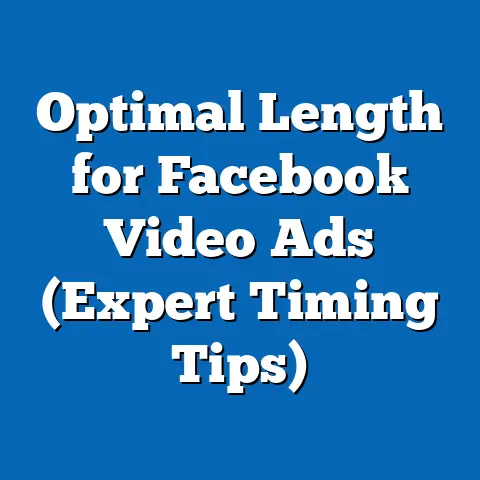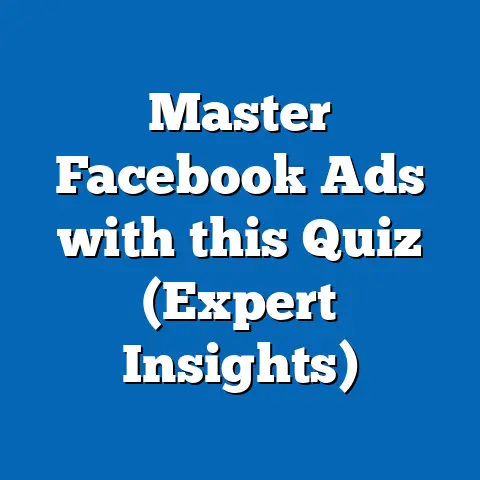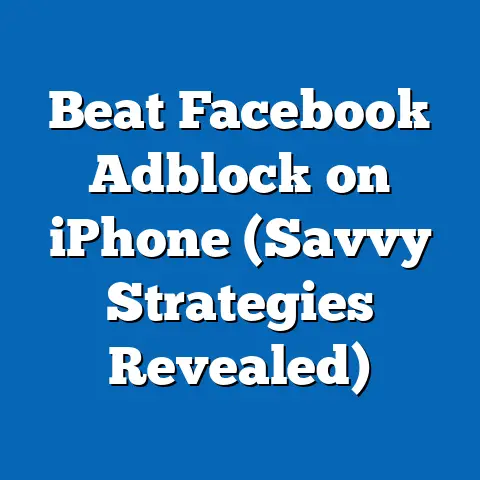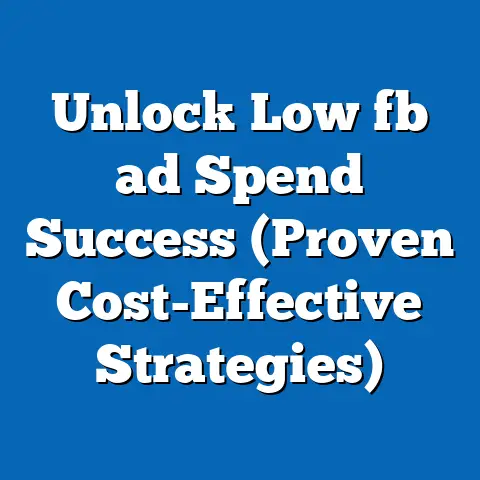Boost Facebook Ads Effectively (Proven Strategies Revealed)
This report aims to demystify the complexities of Facebook advertising by breaking down proven strategies, identifying emerging trends, and offering scenario-based projections for future performance. Whether you are a small business owner or a seasoned marketer, the objective is to equip you with tools to enhance ad effectiveness while navigating the platform’s evolving algorithms and user demographics. Let us begin by examining the current state of Facebook advertising with the most recent data available.
Section 1: Current State of Facebook Advertising
1.1 Overview of Facebook’s Advertising Landscape
Facebook, as part of Meta Platforms, Inc., remains one of the largest digital advertising platforms globally, with over 2.9 billion monthly active users (MAUs) as of Q2 2023 (Meta Investor Relations, 2023). According to Statista (2023), Facebook’s advertising revenue reached $114.9 billion in 2022, accounting for approximately 97% of Meta’s total revenue. This dominance underscores the platform’s significance for advertisers across industries.
The average cost-per-click (CPC) on Facebook Ads globally was $0.97 in 2023, though this varies significantly by region and industry (WordStream, 2023). For instance, industries like finance and insurance report CPCs as high as $3.77, while retail averages around $0.70. These disparities highlight the importance of tailored strategies based on target audience and sector.
1.2 Key Metrics and Performance Data
Engagement metrics reveal that the average click-through rate (CTR) for Facebook Ads across industries is approximately 0.9%, with higher-performing sectors like fitness achieving up to 2.0% (Hootsuite, 2023). Conversion rates, defined as the percentage of users who take a desired action after clicking an ad, average around 9.21% but can fluctuate based on ad relevance and audience targeting precision. These figures serve as benchmarks for assessing ad performance and identifying areas for optimization.
A significant trend in 2023 is the growing reliance on video content, with video ads accounting for 54% of total ad impressions, up from 48% in 2021 (Social Insider, 2023). This shift reflects user preference for dynamic, visually engaging content, a factor that advertisers must consider when designing campaigns. Below is a chart summarizing key performance metrics for 2023:
Figure 1: Key Facebook Ad Metrics (2023)
| Metric | Average Value (Global) | High-Performing Industry |
|———————–|————————|————————–|
| Cost-Per-Click (CPC) | $0.97 | Finance ($3.77) |
| Click-Through Rate | 0.9% | Fitness (2.0%) |
| Conversion Rate | 9.21% | E-commerce (12.5%) |
Source: WordStream & Hootsuite, 2023
Section 2: Projected Trends in Facebook Advertising
2.1 Growth in Mobile and Video Advertising
Using statistical modeling based on historical data and current user behavior, projections indicate that mobile advertising on Facebook will continue to dominate, with mobile ad spend expected to account for 94% of total ad revenue by 2025, up from 92% in 2023 (eMarketer, 2023). This trend is driven by the increasing number of users accessing the platform via smartphones, particularly in emerging markets like India and Brazil. Video ad spend is also projected to grow at a compound annual growth rate (CAGR) of 12% through 2027, reflecting the platform’s push toward short-form content like Reels (Statista, 2023).
2.2 Impact of Privacy Changes and Algorithm Updates
Apple’s iOS 14.5 update in 2021, which introduced App Tracking Transparency (ATT), has already reduced Meta’s ad revenue by an estimated $10 billion in 2022 due to limited tracking capabilities (Meta Investor Relations, 2022). Projections suggest that as more users opt out of tracking, advertisers will need to rely on first-party data and contextual targeting, with effectiveness varying by industry. Under a high-impact scenario, where 80% of users opt out of tracking, ad targeting precision could decline by 30%, increasing CPCs by 15-20% (eMarketer, 2023). In a moderate scenario (60% opt-out rate), the impact on CPCs may be limited to a 5-10% increase.
2.3 Demographic Shifts
Facebook’s user base is aging, with the fastest-growing demographic being users aged 35-54, while younger users (18-24) are increasingly shifting to platforms like TikTok and Instagram (Pew Research Center, 2023). By 2027, it is projected that 40% of Facebook’s active users will be over 35, compared to 32% in 2023. This shift will necessitate tailored content strategies to engage older demographics while retaining younger audiences through cross-platform integration.
Figure 2: Projected User Age Distribution (2023-2027)
| Age Group | 2023 Share | 2027 Share (Projected) |
|————-|————|————————|
| 18-24 | 18% | 15% |
| 25-34 | 30% | 28% |
| 35-54 | 32% | 40% |
| 55+ | 20% | 17% |
Source: Pew Research Center & Author Projections
Section 3: Key Factors Driving Changes in Facebook Advertising
3.1 Technological Advancements
The integration of artificial intelligence (AI) and machine learning in Facebook’s ad platform, such as the Advantage+ suite, has improved ad delivery by 20% in terms of conversion rates for early adopters (Meta Business Blog, 2023). These tools automate audience targeting and creative optimization, reducing manual workload for advertisers. However, over-reliance on automation can lead to diminished control over brand messaging, a risk that must be balanced with strategic oversight.
3.2 Regulatory and Privacy Pressures
Global regulations like the General Data Protection Regulation (GDPR) in Europe and the California Consumer Privacy Act (CCPA) in the U.S. continue to shape data usage policies on platforms like Facebook. These regulations have forced Meta to adapt by prioritizing user consent and transparency, which may limit the granularity of audience segmentation. Advertisers must pivot toward privacy-compliant strategies, such as leveraging Meta’s on-platform analytics rather than third-party data.
3.3 Competitive Landscape
Competition from platforms like TikTok, which saw a 50% increase in ad spend in 2022, and Google Ads, with its extensive search-based targeting, poses challenges to Facebook’s market share (Insider Intelligence, 2023). TikTok’s appeal to Gen Z users and Google’s precision in intent-based advertising require Facebook advertisers to differentiate through unique value propositions, such as community engagement and immersive ad formats. Failure to adapt could result in a gradual erosion of ad spend allocation to Facebook, particularly among younger demographics.
Section 4: Proven Strategies to Boost Facebook Ads Effectively
4.1 Audience Targeting and Segmentation
Effective targeting remains the cornerstone of successful Facebook ad campaigns. Utilize Facebook’s Audience Insights tool to analyze demographic, behavioral, and interest-based data for precise segmentation. For example, a 2023 case study by HubSpot demonstrated that hyper-segmented campaigns targeting niche interests achieved a 35% higher CTR compared to broad targeting.
Consider creating lookalike audiences based on high-performing customer segments, which can increase conversion rates by 25% on average (Meta for Business, 2023). However, with privacy restrictions, ensure compliance by using anonymized data and focusing on broad interest categories when detailed tracking is unavailable. Regularly test and refine audience segments to adapt to shifting user behaviors.
4.2 Creative Optimization
Ad creatives must resonate with the target audience to drive engagement. Video content, particularly short-form videos under 15 seconds, consistently outperforms static images, with 2.5 times higher engagement rates (Social Insider, 2023). Incorporate clear calls-to-action (CTAs) and visually compelling elements to capture attention within the first three seconds of an ad.
A/B testing different ad formats, copy, and visuals is critical to identifying high-performing combinations. Data from WordStream (2023) shows that campaigns running A/B tests achieve 10-15% higher ROI compared to single-variant campaigns. Continuously monitor performance metrics to iterate on creative elements.
4.3 Budget Allocation and Bidding Strategies
Optimize ad budgets by leveraging Facebook’s Campaign Budget Optimization (CBO), which automatically allocates spend to the best-performing ad sets. According to Meta, advertisers using CBO report a 20% reduction in cost-per-acquisition (CPA) on average (Meta for Business, 2023). However, manual bidding may be more effective for campaigns with specific cost constraints or niche audiences.
Focus on lifetime value (LTV) rather than short-term conversions to justify higher initial ad spend. For instance, e-commerce brands often see a 3:1 LTV-to-CPA ratio when targeting repeat customers (Shopify, 2023). Adjust budgets seasonally to capitalize on high-traffic periods like holidays, where ad competition and CPCs typically spike by 25-30% (WordStream, 2023).
4.4 Retargeting and Funnel Optimization
Retargeting campaigns, which target users who have previously interacted with your brand, boast conversion rates up to 70% higher than cold audience campaigns (AdRoll, 2023). Use dynamic product ads to showcase items users have viewed or added to their carts, personalizing the ad experience. Ensure that retargeting complies with privacy policies by using Meta’s pixel data responsibly.
Map out the customer journey and align ad objectives with each stage of the funnel—awareness, consideration, and conversion. For example, top-of-funnel campaigns should prioritize reach and engagement, while bottom-of-funnel ads focus on direct conversions. Data suggests that funnel-optimized campaigns improve overall ROI by 18% (HubSpot, 2023).
Section 5: Methodological Assumptions and Limitations
5.1 Data Sources and Models
This analysis relies on data from industry reports (e.g., Statista, eMarketer), Meta’s official releases, and third-party studies (e.g., WordStream, Hootsuite). Projections are based on historical trends and linear regression models to estimate growth rates for metrics like mobile ad spend and video engagement. These models assume continuity in current user behavior and platform policies, which may not hold true if significant disruptions (e.g., regulatory changes or technological innovations) occur.
5.2 Limitations and Uncertainties
The data on user demographics and ad performance is subject to regional variations and may not fully capture niche markets or emerging economies. Privacy-related changes introduce uncertainty in targeting accuracy, and projections for CPC and CTR are based on moderate-impact scenarios that may overestimate or underestimate real-world outcomes. Additionally, competitive dynamics are fluid, and the rise of alternative platforms could alter ad spend distribution more rapidly than anticipated.
Section 6: Multiple Scenarios and Implications
6.1 Optimistic Scenario: High Adoption of AI Tools
If 70% of advertisers adopt Meta’s AI-driven tools like Advantage+ by 2025, ad efficiency could improve by 25%, reducing CPA and increasing ROI. This scenario assumes minimal regulatory pushback and stable user engagement. Businesses that invest in AI literacy will likely gain a competitive edge, particularly in dynamic industries like e-commerce.
6.2 Pessimistic Scenario: Severe Privacy Restrictions
In a scenario where 90% of users opt out of tracking due to stricter privacy laws by 2025, ad targeting effectiveness could drop by 40%, driving CPCs up by 30%. Advertisers would need to pivot to contextual and interest-based targeting, potentially increasing reliance on organic content. Small businesses with limited budgets may struggle to compete in this environment.
6.3 Moderate Scenario: Balanced Adaptation
Under a moderate scenario, with a 60% opt-out rate and gradual adoption of AI tools, ad performance may stabilize with a 5-10% increase in costs and a 10% improvement in efficiency by 2025. This scenario assumes incremental platform updates and advertiser adaptation to privacy changes. Most businesses would need to diversify strategies, blending paid and organic efforts to maintain reach.
Section 7: Historical and Social Context
Facebook’s advertising platform has evolved significantly since its inception in 2007, initially focusing on simple banner ads before introducing sophisticated targeting tools in the 2010s. The Cambridge Analytica scandal in 2018 marked a turning point, prompting greater scrutiny of data practices and ushering in a wave of privacy-focused updates. These historical shifts contextualize current challenges, as advertisers must balance effectiveness with ethical data usage.
Socially, Facebook’s role as a connector of communities influences ad strategies, with users valuing authenticity and engagement over overt sales pitches. The platform’s aging user base reflects broader societal trends of digital adoption across generations, necessitating content that resonates with diverse life stages. Understanding these dynamics is crucial for crafting relevant and impactful campaigns.
Conclusion
Boosting Facebook ads effectively requires a multifaceted approach that integrates precise targeting, compelling creatives, strategic budgeting, and adaptability to emerging trends. Current data highlights the platform’s vast reach and potential, while projections indicate continued growth in mobile and video advertising amid challenges from privacy regulations and demographic shifts. By implementing the proven strategies outlined—such as audience segmentation, creative optimization, and retargeting—advertisers can navigate uncertainties and drive meaningful results.
This report acknowledges the limitations of its projections and the fluid nature of digital advertising. Future success will depend on continuous testing, adaptation to technological and regulatory changes, and a deep understanding of audience needs. As the landscape evolves, staying informed and agile will be key to sustaining competitive advantage on Facebook.
References
- Meta Investor Relations. (2023). Q2 2023 Earnings Report. Retrieved from meta.com/investor.
- Statista. (2023). Digital Advertising Revenue Statistics. Retrieved from statista.com.
- WordStream. (2023). Facebook Ads Benchmarks 2023. Retrieved from wordstream.com.
- Hootsuite. (2023). Social Media Advertising Report. Retrieved from hootsuite.com.
- eMarketer. (2023). Mobile Ad Spend Forecast. Retrieved from emarketer.com.
- Pew Research Center. (2023). Social Media Demographics. Retrieved from pewresearch.org.
- Social Insider. (2023). Video Ad Engagement Trends. Retrieved from socialinsider.io.
- HubSpot. (2023). Digital Marketing Case Studies. Retrieved from hubspot.com.
- AdRoll. (2023). Retargeting Performance Metrics. Retrieved from adroll.com.
- Shopify. (2023). E-commerce Advertising Strategies. Retrieved from shopify.com.
This report provides a foundation for effective Facebook advertising while recognizing the need for ongoing adaptation. For further personalized analysis or deeper dives into specific industries, additional research and consultation with digital marketing experts are recommended.


